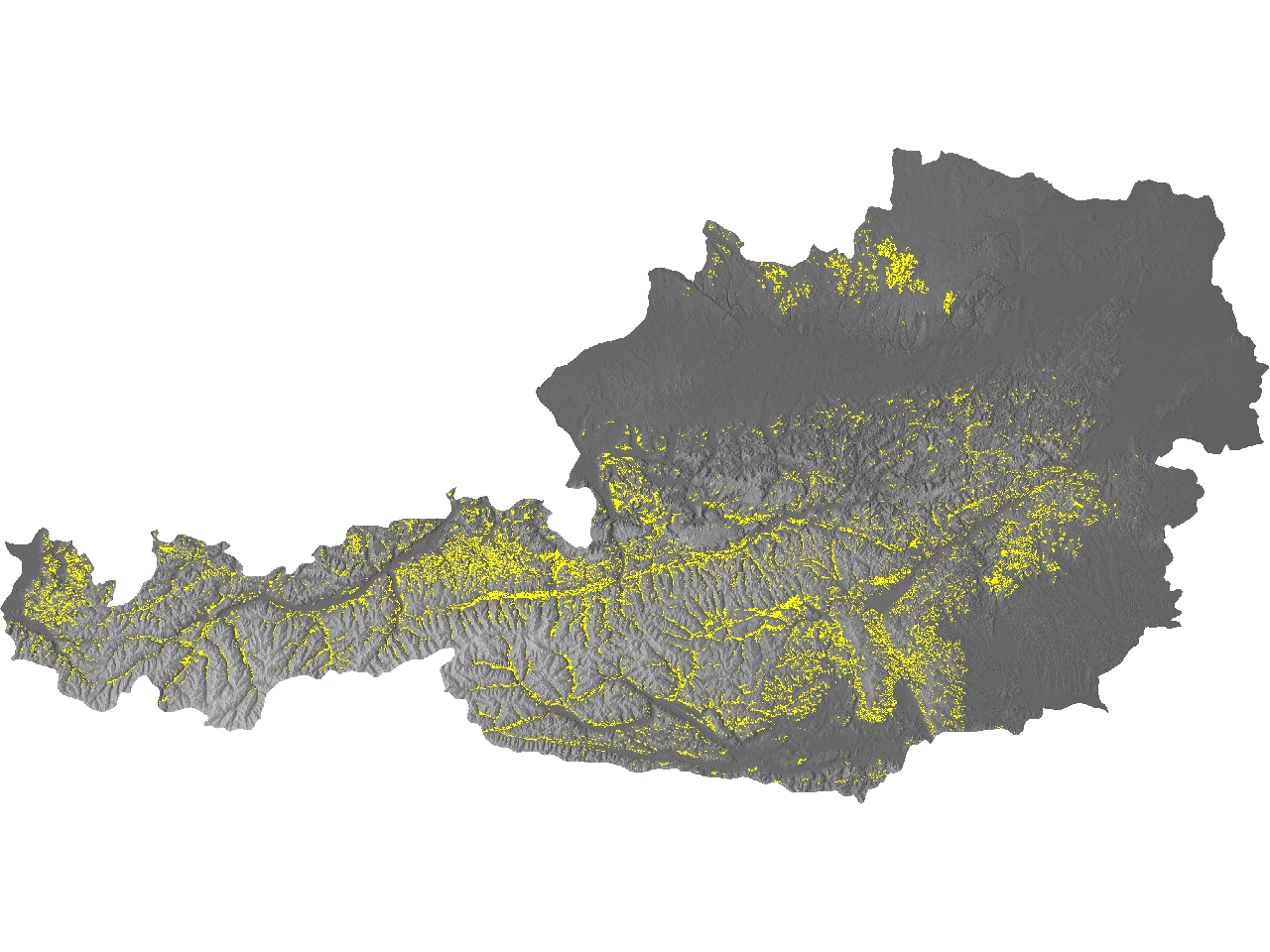These species-rich mesophile hay meadows of the montane and sub-alpine levels (mostly above 600 metres) are usually dominated by Trisetum flavescens and with Heracleum sphondylium, Viola cornuta, Astrantia major, Carum carvi, Crepis mollis, C. pyrenaica, Bistorta major, (Polygonum bistorta), Silene dioica, S. vulgaris, Campanula glomerata, Salvia pratensis, Centaurea nemoralis, Anthoxanthum odoratum, Crocus albiflorus, Geranium phaeum, G. sylvaticum, Narcissus poeticus, Malva moschata, Valeriana repens, Trollius europaeus, Pimpinella major, Muscari botryoides, Lilium bulbiferum, Thlaspi caerulescens, Viola tricolor ssp. subalpina, Phyteuma halleri, P. orbiculare, Primula elatior, Chaerophyllum hirsutum and many others.[2]
Where are these species-rich mesophile hay meadows? Let's try a quick and dirty approach powered by GRASS GIS 7svn and publicly available GIS data.
Recently a EU-DEM was published and ready for public download: [3]
"The Digital Elevation Model over Europe from the GMES RDA project (EU-DEM) is a Digital Surface Model (DSM) representing the first surface as illuminated by the sensors. The EU-DEM dataset is a realisation of the Copernicus programme, managed by the European Commission, DG Enterprise and Industry. The EU-DEM is a hybrid product based on SRTM and ASTER GDEM data fused by a weighted averaging approach."
link to EU-DEMCorine landcover data is able to spatially indicate to pastures and grassland. Let's try: 231 - Pastures, 243 - Land principally occupied by agriculture, with significant areas of natural vegetation, 321 - Natural grasslands. [5]
r.external --verbose input=C:\myrast\EUD_CP-DEMS_4500025000-AA\EUD_CP-DEMS_4500025000-AA\EUD_CP-DEMS_4500025000-AA.tif output=eudem
crop the EU-DEM to the extent of Austria by Natural Earth country vector data
import Corine land cover 2006 seamless vector data restricted to Austria's bounding box
v.in.ogr dsn=C:\myvect\corine2012\clc-2006-vector-data-version-2\clc06_c231.1\clc06_c231.shp spatial=4284730,2595723,4853722,2889837
v.in.ogr dsn=C:\myvect\corine2012\clc-2006-vector-data-version-2\clc06_c243.1\clc06_c243.shp spatial=4284730,2595723,4853722,2889837
v.in.ogr dsn=C:\myvect\corine2012\clc-2006-vector-data-version-2\clc06_c321.1\clc06_c321.shp spatial=4284730,2595723,4853722,2889837
select spatially Corine landcover data for Austria's extent
v.select ainput=clc06_c231 binput=ne_10m_admin_0_countries_at_epsg3035 output=clc06_c231_at operator=within
v.select ainput=clc06_c243 binput=ne_10m_admin_0_countries_at_epsg3035 output=clc06_c243_at operator=within
v.select ainput=clc06_c321 binput=ne_10m_admin_0_countries_at_epsg3035 output=clc06_c321_at operator=within
add and update numerical column for a later rasterization
v.db.addcolumn map=clc06_c321_at columns=cdis integer
v.db.addcolumn map=clc06_c243_at columns=cdis integer
v.db.addcolumn map=clc06_c231_at columns=cdis integer
v.db.update map=clc06_c321_at layer=1 column=cdis value=1
v.db.update map=clc06_c243_at layer=1 column=cdis value=1
v.db.update map=clc06_c231_at layer=1 column=cdis value=1
rasterize Corine landcover data for later masked raster calculations
v.to.rast input=clc06_c231_at type=area output=rast_clc06_c231_at use=attr attrcolumn=cdis
v.to.rast input=clc06_c243_at type=area output=rast_clc06_c243_at use=attr attrcolumn=cdis
v.to.rast input=clc06_c321_at type=area output=rast_clc06_c321_at use=attr attrcolumn=cdis
patch rasterized Corine landcover data
r.patch input=rast_clc06_c231_at,rast_clc06_c243_at,rast_clc06_c321_at output=corine_pastures_grassland
In literature [2] [6] the altitudinal range of mountain hay meadows is given as 600-800m up to 1.400-1.700m. Let's assume 700 - 1.700m here in these calculations.
calculate altitude range 700 - 1.700m of the EU-DEM
r.mapcalc expression=eu_dem_haymeadows_range = if( eudem_austria >= 700 && eudem_austria <= 1700 , 1 )
By combining Corine landcover of pastures and grassland and altitude range we may get some impression of the habitat's potential range.
combine altitude range and corine information
r.mapcalc expression=eu_dem_haymeadows_range_corine = if( eu_dem_haymeadows_range == 1 && corine_pastures_grassland == 1 , 1 , null() )
As we know that pastures and meadows in more ore less flat areas are intensively and heavily used nowadays, species-rich mesophile habitats are getting infrequent. So let's bring slope into calculations.
calculate slope
r.slope.aspect --verbose elevation=eudem_austria slope=eudem_austria_slope_degree
Therefore let's cut very flat, but also very steep areas where other habitats are getting more dominant. So let's refine potential areas by cutting < 3° and > 22°.
slope raster masked by the Corine landcover-altitudinal-range raster and cut steep areasr.mapcalc expression=eudem_austria_slope_degree_masked_refined = if( eudem_austria_slope_degree_masked >= 3 && eudem_austria_slope_degree_masked <= 22 , 1 , null() )
Let's zoom in parts of Tyrol without considering slope
and with slope taken into account for refinement.
It is a nice example that two GIS datasets available to the public and open source GIS software allow a very rough estimation of a habitat's potential range by a quick and dirty approach. Although ground proving and more parameters (e.g. geology, shading, exposition, usage, etc.) are really needed for refinement.
Let's start with ground proving in summer time ... :-)
[1] Initiative Rettet die Blumenwiesen
[2] Interpretation Manual of European Union Habitats (EUR 28, April 2013)
[3] EU-DEM
[4] Natural Earth data - Admin 0 – Countries
[5] Corine Land Cover 2006 seamless vector data
[6] UBA 2005. Entwicklung von Kriterien, Indikatoren und Schwellenwerten zur Beurteilung des Erhaltungszustandes der Natura 2000-Schutzgüter.








Keine Kommentare:
Kommentar veröffentlichen